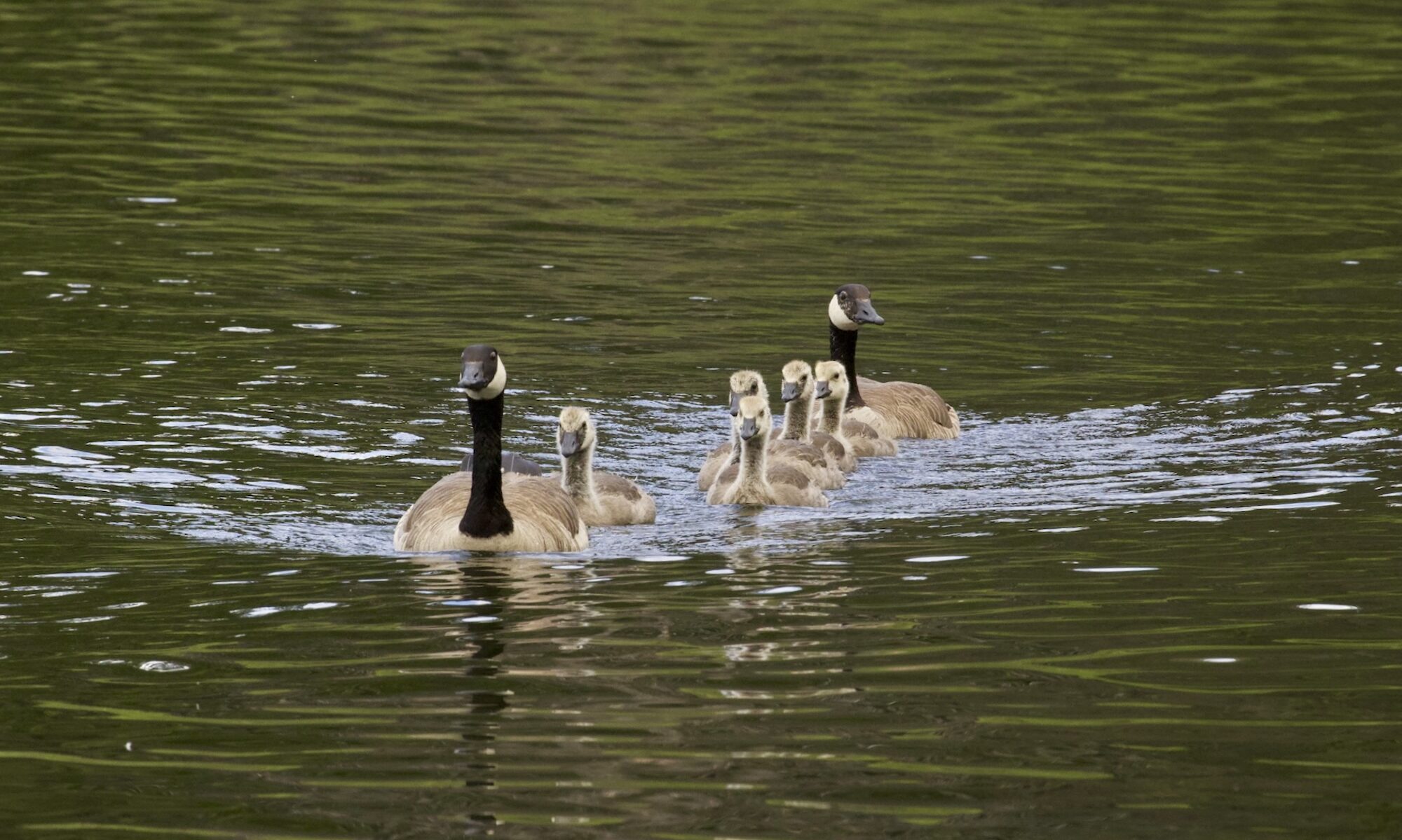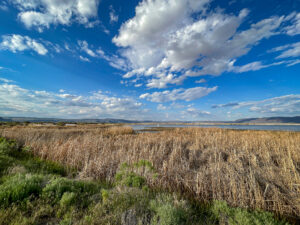
May is a wonderful time for a birding safari. With the garden planted, irrigated, and poised for sunny weather, we headed off for a couple weeks of trailer camping east of the Cascades. The drive to Summer Lake is barely 4 hours, and we arrived there in the early afternoon. Alicia and Leo planned to join us for the first 2 days, and arrived just before dark. She’d already eaten, but we’d set aside leftovers of Sooney’s Bratwurst & sauerkraut that she couldn’t resist. We caught up for awhile in our cozy trailer, and made a plan to rise early and bird the canal Sooney and I had walked earlier that afternoon.
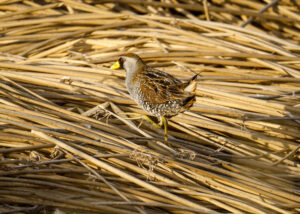
The low morning light was gorgeous, highlighting the bent stalks of reeds shaped by winter snow. They provided perfect habitat for wildlife adapted to wetlands, and Sora and Virginia Rails meandered in and out of the rushes searching the mudflats for tasty morsels. Higher up in the fallen stalks, Marsh Wrens competed with Common Yellowthroat Warblers for optimal nesting grounds. They’d pop up, sing their territorial songs, and drop back into the shafts. We saw one pair of wrens carrying nesting material, and trained our binoculars toward the start of a housing project. We so love the serenity of camping at Anna Creek campground, and usually we were the only ones there. Other guests, if any, prove to be equally interested in the wildlife and we shared pleasantries and a mutual appreciation for privacy.
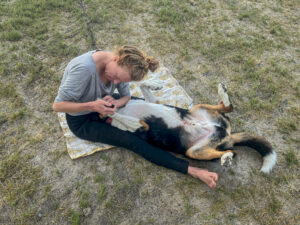
We so looked forward to our time there with Alicia and Leo, of hanging around a couple more days after she returned to Bend, and then driving over to the Malheur Field Station for a three-night visit. Being as it was Memorial Day weekend, we booked 3 nights at the Field Station RV facility since we were familiar with their hookups and sewer connection. Furthermore, it’s off the beaten path and rarely occupied. Once the Memorial Day crowds departed, we planned to drive an hour south to Page Springs CG for another adventure. Plans are, of course, just that. As it turned out, everything turned upside down pretty much from the get-go.
About 3 hours out of Ashland, we stopped for a comfort stop in Silver Lake, 30 minutes from Summer Lake on Hwy. 31. I noticed one of our trailer tires was seriously worn down. In fact, the steel belt was about all that was holding air—if that’s even possible. It’s a miracle it hadn’t blown. That put us into super-cautionary mode, and we took it extra easy for the final 30 miles to the refuge. We had a good spare that I’d swap out once we arrived, and planned on swinging by trusty Les Schwab in Burns en-route to Malheur on Monday. Verizon had pretty good coverage when we arrived, and since it was Thursday we called the tire store to check availability and wouldn’t you just know it—Monday was Memorial day. We had no other option than to cut our Summer Lake visit to a couple days and get to Schwab’s Saturday afternoon before they closed. And that’s exactly what we did. To the tune of $650. Ouch.
With 4 new tires on our Escape, we continued to the Malheur Field Station and found it exactly as expected: empty and our favorite spot just like we left it the last time. So we hooked up, emptied our sewer, powered up our apps, showered, and explored the massive wildlife area over the next 3 days. Just us and the mosquitos.
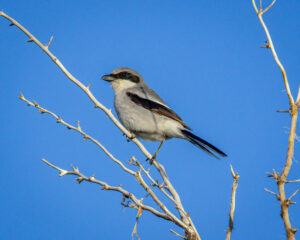
A couple interesting bird behaviors and observations are worth mentioning. While driving Harney Lake road looking for Golden Eagles, we spotted a Loggerhead Shrike perched upon a shrub as is common. We pulled over, and noticed another bird emerge from within the shrub. Speculating that there was a nest in there, we watched as both left and returned to the nest several times. Due to the similarity between males and females, we simply guessed which was which. Later the following day, I photographed another Shrike in late afternoon light and when viewing the image on my computer noticed what we learned was a “Tomial Tooth” next to the hook on the end of its bill. This is also a characteristic of Falcons and Kites and allows the bill “to act like a pair of shears, which may make it easier for the predators to sever the spinal cords of their vertebrate prey.” We enjoyed researching this on Cornell’s Birds of the World, and continue to support its site.
With the bugs ever-present, we mostly birded by car, cruising the Central Patrol roads through the preserve at our wonderful truck’s 4mph idling speed. On the few occasions where I needed to step outside to capture an image, Sooney thoughtfully waved her bandana to discourage the bugs from adding to the bites they’d already taken out of my shoulders and elbows. (Why there has always been confusing to me.) The birding was wonderful (even from the car); I photographed an Eastern Kingbird that was a life bird for me. Sooney is extremely familiar with the behavior of Bobolinks, and we saw 12 of ’em. (Cool fact from the Cornell Lab of Ornithology: The Bobolink is one of the world’s most impressive songbird migrants, traveling some 12,500 miles–20,000 kilometers–to and from southern South America every year.) This is always extraordinary considering Malheur is their farthest western migration before returning deep into So. America in the fall.
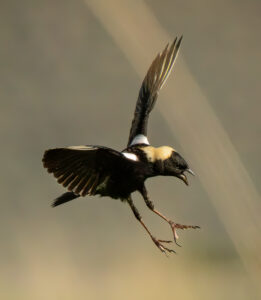
Our original plans were to avoid the Memorial Day crowds by staying at the Field Station and then relocating to one of our favorite campground, Page Springs. Located at the southern end of the preserve, Page Springs features a world-class trout stream, the Dunder Und Blitzen, and has access to hiking trails both along the stream and above on an easily-accessed plateau. We scouted out the bugs down there on our 2nd day, and the place was practically empty. Bugs everywhere, we filled our water bottles from the wonderful springs and birded back to the Field Station along Diamond Lane (“Bobolink” alley).
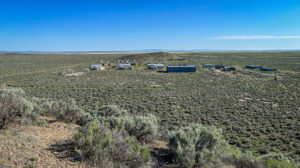
The Malheur Field Station has the disposition of a repurposed army barracks. There are rows of identical bunk houses, a kitchen, some staff houses, an office, and our RV “resort” with 6 spots. They don’t have staff to keep everything up-to-date: paint is peeling off many of the buildings, and 50’s era bungalows are lined up and mostly vacant. Due to its proximity to such excellent birding habitat, the FS is a popular accommodation for birding groups, and income from those visits is slowly upgrading the facility with fresh paint, insulated windows, and a few new manufactured structures on cinder block foundations. We generally get up early, and head out to the nearby Malheur Visitors Center or ply one of the channel road that emanate from the Field Station. After a couple days car birding, we felt a need for a walk somewhere. There’s a trail from the FS to a nearby hill so, life-saving bandanas in hand, we set off for a couple miles hike up the hill. Walking is, by far, the best way to bird (well, right up there with bird kayaking), and we enjoy approaching Meadowlarks without disturbing their lovely call. Once up the hill, looking out over the wetland and the FS below, we were buzzed by a Common Nighthawk. They weren’t really intimidated by us and were flying, mouths open, and vacuuming in mosquitos. An interesting behavior was the periodic times they’d suddenly dive and, in the process of pulling out made a gentle roar (sort of like a throaty “varoooom”) that we observed several times. We’d seen similar behavior by hummingbirds, theorizing it being a mating ritual. But by Nighthawks devouring mosquitos? We’ll simply add it to our long list of reasons we love nature. On our walk back to camp, we spotted the Nighthawk resting in the lower branch of a tree, its long wings folded up and the bird beautifully camouflaged with the bark.
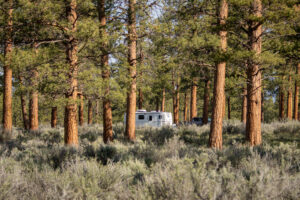
A favorite destination when in Summer Lake is to Fort Rock and the nearby birding blinds maintained by the East Cascades Audubon Society. That didn’t happen in the first go-round due to the tire saga, so we fled Malheur and beelined it back the way we’d arrived (through Christmas Valley) and spent 2 lovely nights disperse camping at Cabin Lake (8.7 miles north of the Fort Rock Day Use Area). The first night we were the only persons there; our site nestled among a gorgeous forest of Ponderosa Pines. That usually means Clark’s Nutcrackers nearby, and in addition to them we spotted Lewis’s Woodpeckers with their lovely pink breasts.
Welcome to Cabin Lake Bird Blind. Here, Ponderosa Pine and sagebrush ecosystems meet, providing one of the greatest concentrations of bird life in the area. (Deschutes National Forest)
We intentionally set up camp a fair distance from the blinds, and the following morning the mile walk to the blinds was epic. Recent rainfall had erased evidence of visitors on the dusty road, and we relished how refreshing it was to be in such isolation. As we neared the blinds, we were greeted by several pairs of Mountain Bluebirds that had taken up residence in some of the many bird houses attached to the huge pines. During the next hour or so, we relaxed in the cushioned vinyl chairs in the blinds; so thoughtful of the hosts. It’s unusual to be 7′ away from a Green-tailed Towhee when outside the blind they wouldn’t let you get within a twenty yards of their perch. But that’s when they sing their beautiful songs, so it’s a fair trade-off.
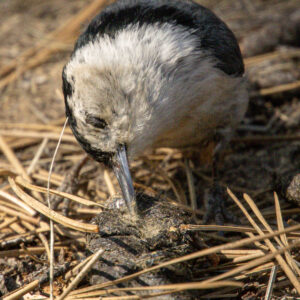
On our second day, some other folks arrived but the disperse camping area is huge so we weren’t impacted. We really hope to return soon and explore some of the myriad roads scattered throughout the forest. We walked a mile up one, and within minutes were all alone again. Some Pygmy Nuthatches caught our attention working on a nest in a large snag. Farther down the road, we spotted a common bird to us, the White-breasted Nuthatch. They regularly visit our suet feeders in Ashland. What was unusual, however, was the determination of that little bird to breakup what we suspected to be dried coyote poop. S/he wasn’t having much luck on the road (a mere 10′ away from us) and grabbed a piece and wedged it into the gnarly bark of a nearby Juniper. It then began pounding on that piece of dung, over and over, breaking it up and spitting bits out. After a few minutes of this, it evidently hit paydirt and flew off with a grassy mouthful. We later asked a veteran birding guide about this, and he suggested two different theories: first, the bird was looking for small bits of food (e.g. larvae, maggots). After taking all it needed for the time being, it flew away to cache the remainder for another snack. A second theory was off our radar: it’s apparently common for some birds to set out “bait” to lure potential food into their pantry. Both plausible and equally interesting.
Our final morning was really cold (27°) and the birding was quiet. The evening before, a site host visited briefly to fill the water troughs and the suet holders in the upper blind. This caused quite a ruckus; at least 20 Piñon Jays spent the better part of an hour devouring it. We spent most of our viewing time in the lower (of the two) blinds, and weren’t impacted by the commotion. When we departed, we spotted a solitary White-headed Woodpecker doing its best to scavenge a few suet crumbs the Jays missed. Nice to see the bird and, from a photographic perspective, it would have been even nicer to have it perched on one of the natural props adjacent to the water.
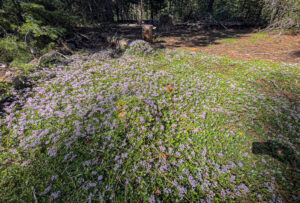
Our final destination is where I’m writing this now. 3 hours from Fort Rock is Juniper Lake, 5-6 miles off Hwy. 97 and located in a lovely California pine forest carpeted with flowering Ceanothus. Our site is #8 (we really lucked out!) and we have a short walk through a field of buttercups to the lake. There’s a ADA-compliant (walking) path around the lake and we birded it in different directions 3 times (it’s all about the light). It was refreshing to rid ourselves of the tether electronic devices have on our daily lives. There was no cell service, but for anyone needing to extend/change/make a reservation, that proved a problem. Somebody stole the payment vault so all bookings must now be made online. Not impacted by this inconvenience, we succumbed to reading in the shade and of being periodically interrupted by some flighty critters. If only the camp host would turn off his damn leaf blower. Postscript: Sooney later learned that blowing flammable material from the pavement is required as a fire-preventive measure every Friday morning. Just our luck
I’ve compiled a gallery of photos from all 4 destinations: Summer Lake, Malheur Field Station, and Cabin & Juanita Lakes.
